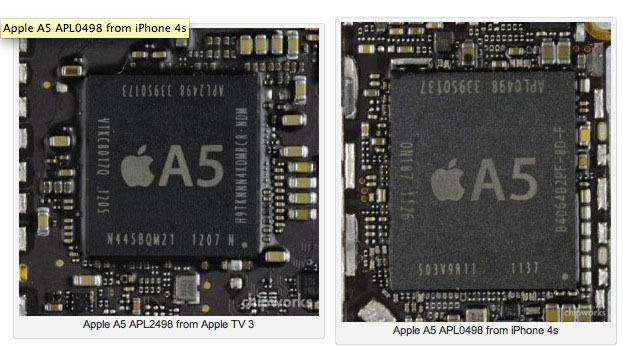
First, the Apple TV A5 chip is 41% smaller than the one powering the
iPhone 4S. Apple and Samsung are probably using a 32 nm engraving
process, if we consider that the A5X powering the new iPad is engraved
at 45 nm, this smaller process is probably reducing cost of production
while offering a manageable size for a small device such as the Apple
TV. Heat release will laso be reduced with thinner engraving.
Then, when looking at it closer, they discovered that the Apple TV A5
chip is a dual core A5 chip in which one core has been disabled. This
will for sure improve production cost as Apple can then either disable
one core, or use CPU in which one core did not pass qualification test.
this method is called Parts binning and contribute to increase the
usable die per wafer while lowering the manufacturing cost.
Now the question is: What is Apple doing with the volume of fully
functional 32 nm engraved dual core A5 chips? Stocking them for powering
the next generation iPod touch?
First, the Apple TV A5 chip is 41% smaller than the one powering the
iPhone 4S. Apple and Samsung are probably using a 32 nm engraving
process, if we consider that the A5X powering the new iPad is engraved
at 45 nm, this smaller process is probably reducing cost of production
while offering a manageable size for a small device such as the Apple
TV. Heat release will laso be reduced with thinner engraving.
Then, when looking at it closer, they discovered that the Apple TV A5
chip is a dual core A5 chip in which one core has been disabled. This
will for sure improve production cost as Apple can then either disable
one core, or use CPU in which one core did not pass qualification test.
this method is called Parts binning and contribute to increase the
usable die per wafer while lowering the manufacturing cost.
.

![[تصویر: in9hd0hdoc4csqizzoo.jpg]](http://www.pic.tooptarinha.com/images/in9hd0hdoc4csqizzoo.jpg)
![[تصویر: rk1ompf38n7vdejwfgg0.jpg]](http://www.pic.tooptarinha.com/images/rk1ompf38n7vdejwfgg0.jpg)

